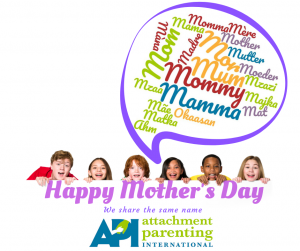By Judy Arnall
What is the scientific purpose of attachment parenting? In short, attachment parenting provides the child stress relief. Every child experiences stress and it impacts the body by triggering a stress response. Emotions such as fear, loneliness, sadness, frustration and unhappiness are present in children as young as babyhood. Children’s response to those emotions is usually crying in babies and “acting out,” crying or screaming in toddlers. Young children do not have the executive functioning to “self-sooth” or regulate their own stress response because of the immaturity of the brain’s pre-frontal cortex. They need external “scaffolding” help from an adult. When a caring adult responds to the situation promptly and with warmth, the stress is soothed and the calmness of the child resumes. Eventually, children grow to an age, usually in the teen years, where their self-regulation skills are developed enough so they can help themselves to “self-sooth,” and the scaffolding may be removed although comfort and parenting is nice to have all through childhood.
There are three kinds of stress; positive, tolerable and toxic. Positive stress is good and everyone needs some of this kind. Positive life challenges in the form or people, events or places, create positive stress. When the child faces the stress and overcomes it, often with caregiver support, (and as they get older, with peer support in addition to adult support); the child builds resilience to adversity and it creates a feeling of accomplishment for them. It encourages the child to meet even greater challenges as they grow because it builds their self-esteem and confidence. When a school child makes a class presentation, or a baby is left with a new loving, supportive caregiver, or a toddler faces new playmates at a new daycare, their accomplishment of managing the positive stress builds their resiliency.
Tolerable stress is caused by negative events in a child’s life. A parent’s divorce, an unwanted move, or the loss of a childhood friend are examples of tolerable stress because they are temporary, and supported by a caring, loving, warm attachment adult who can help steer the child through the stressful time. The adult responds to the child with active listening, lots of hugs, immediate problem-solving and being available for continual help. Even when the child “acts out” their stress by exhibiting bad behaviour, a caring, warm response from an adult will help the child regulate his emotions, return to a calmer state and eventually resolve the problem.
Toxic stress is also caused by negative events although these events tend to be on-going and the one pervasive factor that moves tolerable stress into toxic stress is the lack of a supportive caregiver or attachment parent. On-going, unaddressed bullying at school, or a baby being left to cry it out most nights, or a toddler that is spanked every day for touching items, are examples of toxic stress. In the first example, the bullying is on-going and pervasive. In the last two examples, the adult caregiver no longer is the supportive, caring person, and instead, becomes the source of the toxic stress as in the spanking and leaving to “cry it out” example. When the child has no other adult support resources, they are left to manage the adverse experience on their own.
Of API’s 8 Principles of Parenting, the principles of responding with sensitivity (and not anger), practicing respectful sleep habits (not leaving children to cry-it-out alone) and using positive discipline (non-punitive guidance) are the most important attachment parenting principles to ensure toxic stress does not occur.
Children do not need toxic stress. Ever. The full onslaught of toxic stress stimulates the production of cortisol and adrenaline, which in turn is good in short doses to motivate the body into flight, freeze or fight mode, but bad for the body when it is produced in large ongoing doses. The constant production of these hormones can damage developing brain architecture in children and may produce lifelong consequences later in life in the form of eventual physical and emotional health problems and propensity to addictions.
No one lives a stress-free life, but adults who practice attachment parenting principles can buffer the negative effects of toxic stress in order to turn the stress into tolerable stress and grow healthy, happy children. Loving, caring support is never spoiling a child. It is crucial for a child’s healthy emotional, physical and social development.
Judy Arnall is the past president of Attachment Parenting Canada Association and bestselling author of Attachment Parenting Tips Raising Toddlers To Teens, www.attachmentparenting.ca





